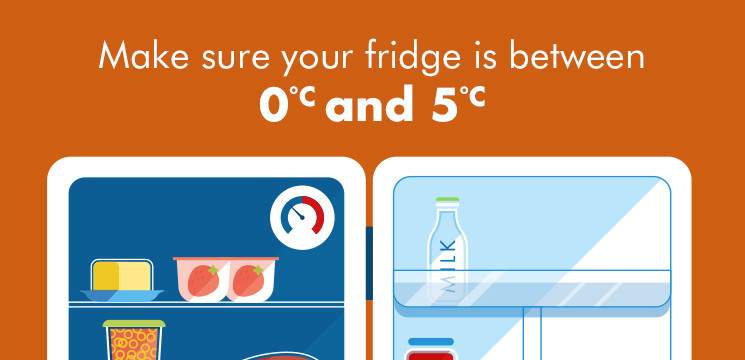Chilling
Stop germs growing by keeping them cold. Look out for a use-by date or 'keep refrigerated' on the label.
Your fridge is a weapon in the battle against germs, but it must be used effectively. Some foods need to be kept in the fridge to help stop or slow down bacterial growth and keep them fresh and safe for longer. Generally, the colder the temperature the slower bacteria will grow, but cold temperatures don't always stop bacteria growing altogether.
Here are a few useful things to remember about chilled foods and your fridge:
- look out for ‘keep refrigerated’ on the food label
- keep your fridge between 0°C and 5°C – and regularly check the temperature with a thermometer. You can use the built in dial/gauge inside the fridge to change the power setting (typically the higher the value the more power the fridge uses to take the temperature down; if in doubt, check the manufacturer’s instructions for your fridge). Note: this built in dial/gauge does not represent the temperature in °C.
- wait for food to cool down before you put it in the fridge (do not let it sit at room temperature for longer than 1-2 hours)
- if your fridge is full, turn the temperature down, but it is best to leave space as this allows air to circulate and maintain the set temperature
- don’t leave the fridge door open
- eat leftovers within two days
- put food back in the fridge as quickly as possible
- when you're eating outside at a barbecue or picnic, use a cool bag or cool box
- if you're putting out food for a party, don't leave it out for more than four hours

Keeping food in the freezer
Freezing is a great way of storing food, keeping leftovers and cutting down waste. Freezing acts as a ‘pause’ button prior to any use-by date expiring and most bacteria cannot grow at these low temperatures. Your freezer should be around -18°C. For safety, it's ok to freeze most raw or cooked foods providing you do the following things:
- freeze food up until the 'use by' date
- follow any freezing or defrosting instructions on the label
- defrost food in the fridge so that it doesn't get too warm
- use food within one to two days after it’s been defrosted – it will go off in the same way as if it were fresh
- only reheat food that has been frozen once – freezing in smaller portions will help
Visit our date labelling page for more information on use-by and best before dates.
Under the microscope — the 'Danger Zone'
It is important to remember that freezing food does not kill some harmful bacteria in food. Bacterial growth can be ‘paused’ at these low temperatures but then can start to grow again at higher temperatures.
Therefore, when defrosting meat it is safest to do so in the fridge because when food is above 8°C and below 63°C bacteria can grow and multiply – this is known as the ‘Danger Zone’ for microbial growth. That’s why we advise that the safest way to defrost food is in the fridge overnight. By defrosting in the fridge, your food should never enter the ‘Danger Zone’.

Tips for defrosting
Defrosting meat and fish can leave them in a puddle. This liquid could contain harmful bacteria so it’s best to keep it covered or in a sealed container on the bottom shelf of the fridge so it can’t drip down onto other food.
Always clean surfaces, utensils, plates and hands thoroughly after they have touched raw or thawing meat to stop bacteria spreading around the kitchen.
You can freeze food again once cooked, but you’ll only be able to reheat it once after that.
Defrosting food - BSL
Nothing spoils summer like Pink Chicken
Food poisoning can wreck your summer barbecue. Keep pink chicken – and nasty food bugs – off the menu.
Cleaning
Keep yourself and your kitchen clean by washing and drying your hands thoroughly.
Cooking food
Food poisoning isn’t just something you get outside your home – the meals you prepare can be a source of food poisoning too.